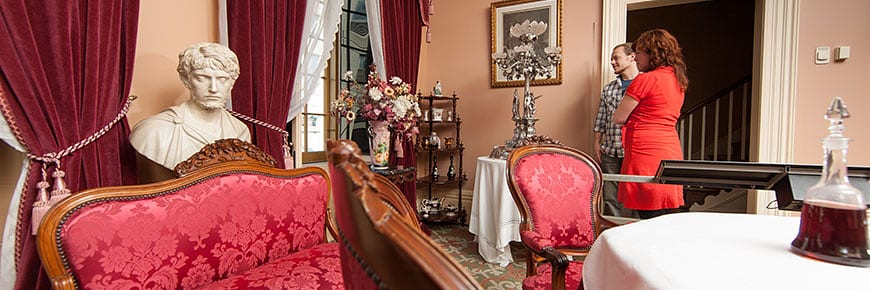Residence of Sir George-Étienne Cartier, illustrious French-Canadian politician and Father of the Confederation

George-Étienne Cartier lived in this bourgeois residence on Notre-Dame Street in Montreal between 1848 and 1872, from the beginning to the end of his brilliant political career. Among his many achievements, his most memorable was undoubtedly as one of the principal architects of Canadian Confederation, and later of Canada’s westward expansion. Fully furnished in the style favoured by the Cartier family, this residence allows visitors to discover the interior of a 19th-century Victorian residence and the lifestyle of its inhabitants. Information is also presented on the political debates that preceded the creation of Canada, and the positions held by Cartier.
To find out more…
The privilege of visiting the Cartier family home
In Montreal, the Maison George-Étienne-Cartier offers the public a rare privilege: that of visiting the interior of a plush residence from the second half of the 19th century, faithfully reconstructed, including some of the objects that belonged to the members of this influential family. The Cartier family’s affluence is reflected in the elaborate furnishings, fine woodwork and delicate yet abundant decoration, all of which confirm at first glance the high social status of its inhabitants. Travel trunks, photographs, desk accessories, sewing equipment, crockery and other objects provide a glimpse into their lifestyle.
Inspired by the diaries of Hortense and Joséphine, two of the Cartier-Fabre couple’s three daughters, the objects on display in their bedroom evoke slices of the lives of these young Montreal bourgeois. At Christmas time, visitors can discover the amalgam of French and English traditions that the Cartier family liked to celebrate at this time of year. Like many members of the French-Canadian elite of the time, the Cartiers were influenced by the British hold on Quebec, Canada and much of the world. So much so, in fact, that in an interview with the Queen of England, Cartier was quoted as saying that an inhabitant of Lower Canada was an Englishman who spoke French. This comment could not, however, be applied to the entire French-Canadian population, some of whom remained very attached to their French origins.
The historic compromise of Canadian Confederation
In the politically unstable years of 1850-1860, Cartier played a key role in the development of the Canadian Confederation project. Convinced of the superiority of British institutions compared to those of the United States, Cartier developed, promoted and negotiated a political project inspired by British traditions, but adapted to Canada’s case, in that it aimed in particular to grant equal rights to French- and English-speaking communities. The federal level of this proposed confederation would have more powers than the provincial levels, which would nevertheless benefit from specific powers in areas such as education and culture, important to French Canadians.
Among the architects of Canada, Cartier was the main proponent of a decentralized state that would maintain a certain balance between federal and provincial powers. In the end, this compromise won enough support to bring about Canadian Confederation in 1867, a process that continues to this day.
Theory and practice
On the question of Francophone rights, the application of the Canadian political system was not as successful as Cartier had hoped. In the predominantly English-speaking provinces, the right to education in French was quickly limited, if not virtually eliminated. At the federal level, Anglophones, who were also the majority in Canada as a whole, quickly dominated the political scene and marginalized French-speaking communities outside the province of Quebec, where the only French-speaking majority was located. As a result, the project Cartier had fought for only partially withstood the application of the principles on which it was based. Until recently, with the repatriation of the Canadian Constitution from London to Ottawa in 1982, Francophones in minority situations were able to regain certain essential rights, such as the right to education in French.
Cartier’s legacy
Cartier’s important contribution to the creation of Canada is not the only legacy of this great politician. As early as 1868, he travelled to London to negotiate the cession of the Hudson’s Bay Company’s immense private territory to the fledgling Canada, rather than to the United States, which wished to acquire it in addition to Alaska. The purchase of this territory in 1870 considerably increased the size of Canada, particularly to the west. Cartier also played a key role in the admission of Manitoba into Confederation in 1870, followed by British Columbia in 1871. He was also one of the architects of the Canadian transcontinental railroad project, in which he had a hidden interest that led to scandal. Finally, in Quebec, he was involved in the introduction of the Municipal Act, school reforms and the Civil Code.
The Georges-Étienne-Cartier house is part of the Montréal heritage site, declared by the Québec government.





